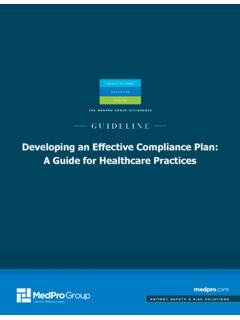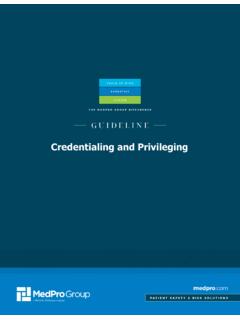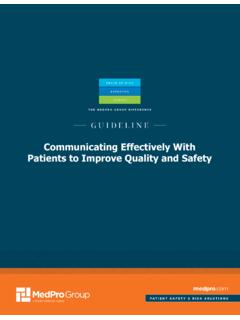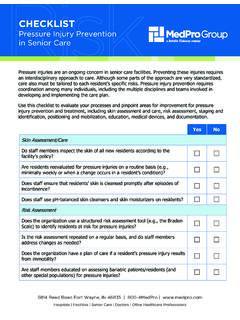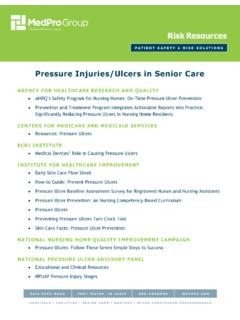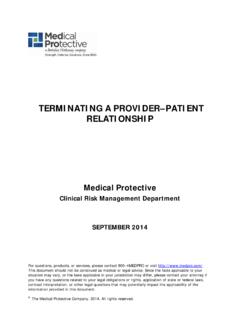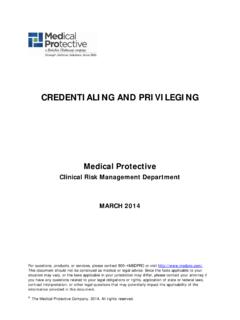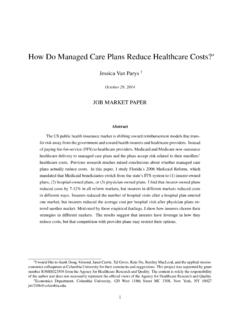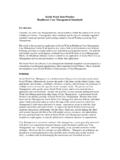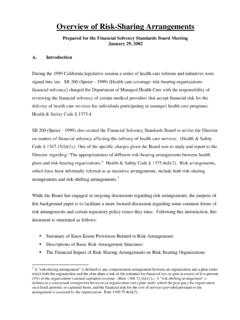Transcription of Medical Equipment Management - MedPro
1 Guideline Title Medical Equipment Management This document does not constitute legal or Medical advice and should not be construed as rules or establishing a standard of care. Because the facts applicable to your situation may vary, or the laws applicable in your jurisdiction may differ, please contact your attorney or other professional advisors if you have any questions related to your legal or Medical obligations or rights, state or federal laws, contract interpretation, or other legal questions. MedPro Group is the marketing name used to refer to the insurance operations of The Medical Protective Company, Princeton Insurance Company, PLICO, Inc. and MedPro RRG Risk Retention Group. All insurance products are underwritten and administered by these and other Berkshire Hathaway affiliates, including National Fire & Marine Insurance Company.
2 Product availability is based upon business and/or regulatory approval and may differ among companies. 2022 MedPro Group Inc. All rights reserved. Contents Introduction .. 1 Objectives .. 1 Equipment Selection and Acquisition .. 1 Equipment Management .. 3 Inventory Management and Documentation .. 4 Evaluation of Equipment .. 5 Testing .. 5 Maintenance and Usage .. 6 Education and Training .. 7 Incident Response Procedure .. 7 Equipment Recalls .. 8 9 Onsite Laboratory, Anesthesia, Sterilization, Dialysis, or Radiology Services .. 10 Patient-Supplied Medical Equipment .. 11 Conclusion .. 12 Resources .. 13 Endnotes .. 13 Appendix A. Sample Equipment Inventory/Tracking Log .. 14 Appendix B. Sample Log of Preventive Maintenance and Repairs .. 15 Guideline: Medical Equipment Management 1 Introduction Medical Equipment plays a vital role in healthcare ; however, when Equipment is not properly used or maintained, it also can cause harm.
3 In many instances, patient injuries occur because of assumptions about who may use, calibrate, modify, or repair Equipment . Injuries from Medical Equipment also might arise from training gaps that don t address pre-use testing, preventive maintenance, malfunction reports (and incident reports), and repair procedures. A commitment to safety is an essential element of any process related to the use of Medical Equipment whether the Medical Equipment is purchased, rented, borrowed, or leased. Objectives The objectives of this guideline are to: Review due diligence considerations for selecting and acquiring Medical devices and Equipment Define key aspects of an Equipment Management program and offer risk strategies to consider when developing such a program Discuss the necessary components of a well-defined incident response procedure Offer guidance related to responding to Equipment recalls and documenting essential information about Medical devices and Equipment Provide general recommendations for managing risks associated with the operation of onsite laboratory and radiology Equipment Review proactive strategies for addressing patient-supplied Medical Equipment Equipment Selection and Acquisition The selection of Medical Equipment should not be based on hasty or insufficient decision-making.
4 Each healthcare organization ( , practices, hospitals, clinics, and large health systems) should formally establish a team that is responsible for researching and recommending Medical Equipment . Guideline: Medical Equipment Management 2 Once recommendations are made, prospective Equipment should be thoroughly reviewed in a collaborative effort by end users especially if it will be used in the direct diagnosis, treatment, or care of patients. Due diligence when selecting Medical Equipment might include: A literature review Consultation with experts Consideration of whether to contract the services of a biomedical engineering company Requests for data and research results from clinical trials Discussions with other healthcare providers who use the same Equipment (follow-up of references) A review of the history and fiscal standing of potential vendors The Medical Equipment selection process also should include a formal assessment of the anticipated risks and benefits associated with the Equipment .
5 For example, consider the following questions: Is the use of the Equipment consistent with your healthcare organization s mission and ethical policies and procedures? Does the Equipment or new technology reduce the risk of injury to patients or staff members who may be required to use it ( , exposure to lower levels of radiation, latex, or mercury)? Do health benefits and/or time-savings for patients, healthcare providers, and staff outweigh the cost associated with the Equipment ? Will the Equipment require any costly software upgrades? Can the manufacturer supply a schedule of upgrades? Will charges to the patient that are associated with this Equipment remain consistent with similar community pricing? Are the procedures for which the Equipment is used billable? Does your electronic health record (EHR) system or billing system need to be modified to bill for these services?
6 Guideline: Medical Equipment Management 3 What is the community standard? Are market pressures influencing the decision to purchase new Equipment ( , our competition offers it or we don t want to be left behind )? Do staff and providers need to be aware of any regulatory requirements related to the Equipment ( , only licensed independent practitioners can operate the Equipment , environmental safety requirements, etc.)? Are you able to integrate direct patient care Equipment ( , blood pressure monitors and laboratory Equipment ) with your EHR (if appropriate)? If not, what additional resources would be required to do so? Does the new Equipment require additional supplies or materials to use or maintain it? If so, what are the availability and costs of these items? Is vendor support or other technical support for maintenance available?
7 Have you considered the purchase/lease requirements and options ( , warranties, volume purchasing, trade-in programs, upgrades, indemnification for injuries/failures, contract terms, new versus used/refurbished Equipment , etc.)? What are the training and ongoing competency considerations? The answers to these questions and the rationale for purchasing the Equipment should be documented and saved for future reference. Equipment Management A patient injury caused by a Medical device or piece of Medical Equipment may trigger a claim against a practitioner, healthcare organization, and/or an Equipment manufacturer. To reduce patient safety and liability risks associated with Medical devices and Equipment , healthcare organizations should have effective programs for managing Equipment used in patient care. Considerations when developing an Equipment Management program include inventory Management and documentation; evaluation of Equipment ; testing; maintenance and usage; and education and training.
8 Guideline: Medical Equipment Management 4 Inventory Management and Documentation A first step in designing an effective Equipment Management program is documenting what Equipment you have. Each healthcare organization should: Maintain an inventory of all Medical Equipment , whether it is leased or owned and whether it is maintained according to manufacturer recommendations or an alternative Equipment maintenance (AEM) Include as part of the inventory a record of maintenance activities. (See Appendix A and Appendix B for sample tracking and maintenance/repair logs.) Ensure that Equipment managed through an AEM program is clearly identifiable as subject to AEM. Further, critical Equipment whether subject to AEM or not must be readily identified as such. Document the following information for all Equipment included in the inventory: Unique identification number Equipment manufacturer Model number and serial number Description of the Equipment Location of the Equipment (for Equipment generally kept in a fixed location) Identity of the department considered to own the Equipment Risk Tip If an organization opts to use a biomedical engineering contractor s Equipment Management plan, designated personnel at the facility should review and adopt that plan.
9 Language in the plan should specifically refer to the organization; it should not be a boilerplate plan that fails to integrate services and responsibilities between the organization and the contractor. Guideline: Medical Equipment Management 5 Evaluation of Equipment In addition to having a written inventory of Medical Equipment , healthcare providers and staff should understand the purpose of each piece of Equipment . As part of the Equipment Management program, each organization should: Evaluate each piece of Equipment to determine: Function and clinical application Preventive maintenance requirements and expected lifespan Likelihood of Equipment failure; check Food and Drug Administration (FDA) reports, consumer reviews, and literature reviews Compatibility with other Equipment used at the facility Space allocation for Equipment and supplies Once the Equipment has been evaluated, assign each item a tier level (1, 2, or 3) based on how critical its function is to the practice or patient.
10 Tier 1 is for the most critical Equipment , such as life support and emergency devices ( , an automatic external defibrillator). Tier 2 is for common use Equipment , such as blood pressure monitors and heat therapy units. Tier 3 is for Equipment that has little to no risk, such as a patient scale. Testing Testing Medical Equipment is an essential element of an Equipment Management program and vital for patient and staff safety. Each organization should: Test Equipment based on manufacturer recommendations or the tier level assigned (whichever is most frequent): Equipment in Tier 1 should be tested on at least a semi-annual basis. Equipment in Tier 2 should be tested on at least an annual basis. Equipment in Tier 3 may only need to be visually inspected on an annual basis. Guideline: Medical Equipment Management 6 Ensure that qualified personnel inspect, test, and maintain all Medical Equipment (diagnostic, therapeutic, life support, and monitoring).
